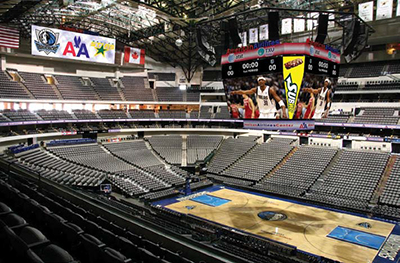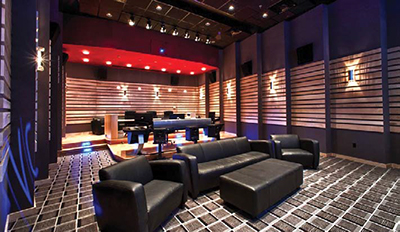Wrangling 14-Channel Sound in Dallas
The American Airlines Center, home to the Dallas Mavericks NBA team and the Dallas Stars NHL team, seats 18,000 and opened in July 2001. DALLAS—At Dallas Audio Post, where René Coronado is lead sound designer and more, the job descriptions continue to change and the five-person business evolves to make it all work. “We do TV mixes, film mixes, music composition and ENG recording,” Coronado said. “I do most of the big sound design jobs, but it’s not unusual that [owner /creative director/supervising sound editor] Roy Machado, [music supervisor/ composer] Brad Dale and [composer / sound designer] Evan Arnett all have their hands on some part of each project.” Office Manager Gloria Presutti, the fifth member of the team, is also an associate producer.

Two of their more interesting projects are providing 14-channel sound design for The NHL Dallas Stars and NBA Dallas Mavericks. Both teams play in the 18,000-seat American Airlines Center, an enclosed arena near I-35E in Dallas.
TRIAL AND ERROR
Sound designing and mixing 14 channels for a space that large requires different considerations than mono, stereo or 5.1. Coronado says his templates, signal flow and routing are the result of multiple trial and error. “I don’t have a 14-channel monitor system, so I route everything that will be heard in the arena through a matrix to my 5.1 surround monitors,” he said.
Dallas Audio Post has four control rooms, four recording spaces and one Dolby Certified surround mix stage. Audio is stored on Fibre Channel drives that can be accessed from any of the four control rooms or the Dolby Stage. Coronado uses Digidesign 192 hardware and Pro Tools 10 in the studios with Meyer Sound Lab 1032a for the L/C/Rs and Meyer 1030 for rear surrounds. On the Dolby mix stage they use Pro Tools 11 and a Meyer Acheron monitoring system.

Dallas Audio Post has four control rooms, four recording spaces and one Dolby Premier Studio Certification surround mix stage. It is out of this audio kitchen that Coronado cooks up the sound design elements for the big open videos that play just before the Mavs or Stars come out for introductions. “The stereo left and right are two of those channels and then there are 12 speakers around the area that shoot down over the area from the edges,” he said. “The mix plays back from a Windows laptop running Pro Tools through a USB connection to a Digidesign Venue mixer at the arena.”
Coronado says timing adjustments are made during a tech rehearsal in the arena. “There’s video going to the video boards, and a 360- degree video ring about a foot tall that runs around the entire arena just below the lower balcony,” he said. “The video has the master time code. There are 20-30 seconds of just firing time code to make sure everything is sync-ed. That delay means you can’t have a 14 channel cue, then stop, then instantly have another.”
LIMIT REVERB
Stereo in the studio and 5.1 on the mix stage doesn’t always translate to the ACC arena’s 14-channel system. “There are things that you learn through trial and error that work and things that don’t work (laughs),” he said. “If I put sounds out randomly to different monitors, I can hear them sort of bouncing around in the control room, but in the ACC arena, as a member of the audience, you can only hear the monitor above you or maybe the one adjacent to you. Anything else just sounds like reverb.”
Get the TV Tech Newsletter
The professional video industry's #1 source for news, trends and product and tech information. Sign up below.
Coronado says he’s limited to making things fly overhead, making sound rotate in circles, or pushing things outward from the center hang speakers to the surrounds. “The surround speakers are not delayed and not aimed in the same direction as the center hang, so you can’t time align them,” he said. “Plus, all the subs are in the center hang which means all my low end comes from the center. All my surrounds high pass at the board at 300 Hz. So my surrounds are both not time aligned and mids and highs only.”
With his musical vocabulary limited to pads and swells that correlate musically, Coronado says any rhythmic sounds like music or anything with a beat coming out of both the center and the surrounds would just be a jumble, so he avoids doing that.
Then there’s the spatial difference between his control room and the arena. “The distance between the speakers and the amount of reverb in the arena take some time to understand,” Coronado said. “The arena is actually well designed, treated very well and sounds beautiful. There’s all kinds of beautiful baffling up on the roof that keep it pretty chilled out, but there is reverberation and it’s pretty long. So, as I’m creating content, I don’t ‘verb’ stuff out too much. In fact, in the control room, I monitor through some reverb to approximate what may happen in the arena so I can get a feel for what will go on there.”
With that much natural reverb, Coronado doesn’t need to add much. “It really reduces the intelligibility,” he said. “Last year there was a speech given by the Stars owner integrated into the open video,” he said. “In those situations I have to be very careful to make sure the mix pops that track up pretty hot.” Coronado lives close to the arena and checks in frequently to make sure his mixes are translating well.
“Sometimes I’ll hear something that doesn’t work the way I heard it in the studio and I’ll come back, remix and deliver a new mix to the arena.”
